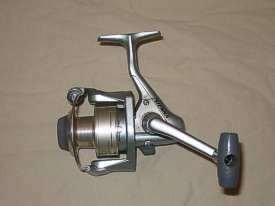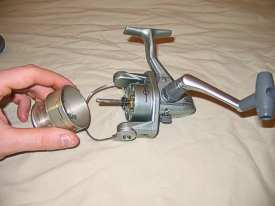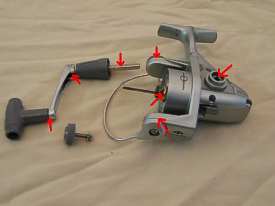|
Spinning Reel Maintenance
By
Tim Allard
Reel maintenance is often overlooked by anglers and
negligence leads to damaged gear that can fail under pressure. This
article is an overview of spinning reel maintenance. To get the
details on reel upkeep, I contacted Steve Gribbon, owner of Reel to
Reel Plus, a fishing reel and rod repair company in Stittsville,
Ontario.

Begin by placing the reel on a rag to protect your
working area, and to track disassembled components.
The Right Lubricants
"The most common error we see for lubrication is use of too much
lubricant and use of the wrong type of lubricant or cleaner. You
will either require oil or grease depending on your reel," Gribbon
explains.
He recommends, "A light machine oil, such as 3-in-one, or special
purpose reel oil. Over the long term WD-40 and other water
displacing lubricants can leave a deposit so use it infrequently.
General purpose fishing reel oil is recommended. The main point is
low viscosity. Vegetable based oils, fats, or cooking oils get thick
in the cold and should not be used. Do not use mineral oil; it
damages some plastics and rubber parts."
Grease should be specific to fishing reels. Do not use Vaseline,
lard or shortening. "For ice or late fall fishing, low viscosity
reel grease, usually lithium based will perform best," he adds.
Workplace Set-Up and Reel Inspection
Before disassembling your reel, organize your tools, materials
and workspace. A small screwdriver set is often enough for reel
disassembly. Rags and Q-tips are great for cleaning. A drop sheet
will keep your workspace clean and parts together.

Remove the spool and wipe the interior and reel
shaft clean.
 ] ]
Reel_Oil_Arrows:
The arrows indicate some common areas requiring lubrication on
spinning reels. Refer to the owner's manual for detail on whether to
use grease or oil.
Obtain the owners manual and a schematic for your reel. They provide
assembly information and maintenance tips. Some manufactures provide
these documents free on the Internet.
Clean the outside of the reel and monitor its operation before
taking it apart. Gribbon recommends this to determine if the reel is
damaged or if parts need replacement. Turn the reel handle and
listen for odd sounds, like clicks or rubbing noises. Such sounds
indicate damaged reels parts.
"Tighten the drag and ensure it generates lots of resistance against
line being fed or the spool being turned. Free the drag back almost
to nothing. The spool should turn easily with your hand. You need a
fairly wide range of drag adjustment; if you don't the drag washers
may need replacement."
"Try using the bail several times, twenty or more. Ensure it flips
with a good snap. If not, it may be mounted to tight, or the bail
spring is worn. Check the anti reverse and other features. All
should move smoothly, quietly and reliably - like a new car. Give
the handle a couple of turns and allow it to freewheel. The handle
should easily cover three or four rotations, even an old reel."
Cleaning and Maintenance
When disassembling your reel, keep parts in the order you
removed them, following the schematic, storing them on the drop
sheet. Clean the reel by removing the spool from the main body. With
a clean rag, wipe the inside of the spool and the main shaft. Next,
clean the exterior of the reel body. Remove the reel handle and, if
needed, clean it as well.
Once the components are clean, Gribbon "Applies a very thin coat of
grease to the shaft. If you can, remove the drag washer stack and
clean them with a dry cloth. This is easier in a front drag reel,
some rear drag reels must be well disassembled to free up the washer
stack. Apply a bit of grease, a very light film as recommended by
the manufacturer's instructions, to the drag washers. Some washers
are not to be greased. Leather washers usually use oil. Again, read
the manual. Inspect drag parts as you take them apart and clean
them, if you see cracks, chips, eccentric holes, metal filings or
powder, uneven wear, very thin washers, or very shiny grooves,
something needs replacement."
You may also need to add some lubricant to the other moving parts of
the reel such as the bail or handle.
Annual Maintenance:
Once a year, Gribbon recommends opening the body and looking for
dirt and debris, adding, "Loose parts or metal bits indicates damage
and need for a repair."
"Remove excess lubricant and apply a very small quantity of
lubricant to the shaft, handle bushings or bearings and the teeth of
the main gear or pinion as recommended by the manufacturer. If the
inside is very gritty or dirty, or filled with caked grease, common
in an inherited reel, we have solvents purpose designed to remove
it. Manually, you can use Q-tip, or cloth."
"To lube older open bearings, use a bit of grease. Lube newer
bearings with oil, never solvent, and only once a year. Do not pack
the reel body with grease unless absolutely recommended by the
manufacture."
To keep your reel in proper working order, clean and lubricate it a
few times a year, and before any major fishing trips. Just like a
car, keeping your lubricants "topped up" will ensure moving parts
function properly and don't fail.
|